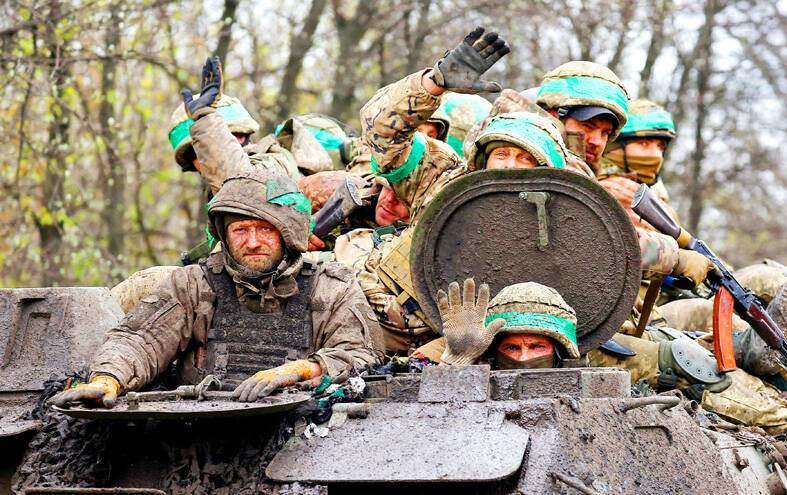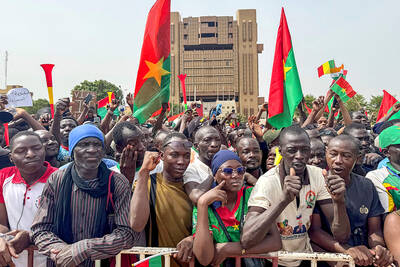In a muddied trench under fire from Russian forces 200m away, Ukrainian military personnel injured while holding the line near the bloodiest battle of Moscow’s invasion face a precarious extraction.
“If someone gets unlucky, we have to carry them between one and 3km to the nearest place they can be collected,” a Ukrainian soldier who calls himself Begemot said several kilometers from the embattled city of Bakhmut.
“Even a light injury can be fatal in these conditions,” he added, the sound of artillery thundering behind him.

Photo: Reuters
The difficulty of hauling out injured troops is just one among the myriad factors dictating the timing of a highly anticipated Ukrainian counteroffensive against Russian positions across the sprawling front line.
Ukraine is understood to be stockpiling precision ammunition, mass recruiting assault battalions and mastering Western-supplied arms in preparation for a decisive pushback against Russian forces.
Observers of the Kremlin’s invasion say that after fending off a months-long lackluster Russian offensive in the eastern Donetsk region, Ukraine could hit back within weeks.
However, in the water-logged eastern industrial Donetsk region, Ukrainian soldiers tasked with holding the line against waves of Russian forces say: not yet.
“Any military hardware that passes here, their undercarriage will get stuck in the mud. They’ll be targets. We can’t talk about a counteroffensive yet,” Begemot said.
Agence France-Presse journalists moving toward a frontline position near Bakhmut saw Ukrainian troops dislodging by hand their transport stuck in the mud.
Watching over that very same battlefield from footage streamed by drones over the trenches, 42-year-old battalion commander Evgeny sees assault as inevitable.
“It’s going to happen. Clearly. The situation on the front line dictates that, but a counteroffensive can only happen when the enemy’s forces are exhausted,” he said.
Evgeny said that even over the weeks his troops have been tasked with containing Russian forces from advancing around Bakhmut’s flanks, the attackers have been loosing steam.
“We have to grind them down so they can’t relocate their forces,” he said, describing in detail how Russian forces send waves of dispensable, then more experienced fighters toward his trenches.
Based on intercepted radio communications and footage his drones feed back to the bunker, he believes Russian forces — still pushing deeper inside Bakhmut — are ultimately preparing for Ukraine to attack, too.
“The enemy has started to lay mines along sections of their lines, which means they are tired. They’re preparing to defend,” he said.
That was a sentiment echoed this week by Russian mercenary chief Yevgeny Prigozhin whose fighting force, Wagner, has been spearheading the assault for Bakhmut.
“The ideal option would be to announce the end of the conflict and to tell everyone that Russia has achieved its objective, and in a sense, we have really achieved them,” Prigozhin wrote on social media.
“Now only one thing remains: gain a firm foothold and dig into the territories that we already control,” the 61-year-old Kremlin ally said.
For civilians in the crossfire — those who have not already fled more than a year of intense fighting — the prospect of an escalation changes little.
Several kilometers west of Bakhmut, in the village of Kalynivka, 71-year-old Vera Petrova gestured to the artillery damage to her home to explain why she was not making preparations to flee a counter-offensive.
“We’ve already been shelled. Half the kitchen roof was destroyed. Our neighbor’s roof was destroyed. This isn’t even serious,” she said referring to thuds, near and distant, of incoming and outgoing shelling.
Her street, lined with cherry trees and abandoned one-story homes, has only about two dozen residents remaining — a fraction of those who once called it home.
“If my home is destroyed. I’ll live in my basement,” she said, not flinching after each boom.
In the trenches, Begemot said that even if Ukraine manages to increase the rhythm of the artillery fire, it would be senseless to attack now.
“Even if there are a lot of us, and we had a bunch of artillery, how far could we go in one day? Five kilometers? Maybe 10?”
“They won’t have any strength left and you are not just walking, you need to fight,” he said.

Kehinde Sanni spends his days smoothing out dents and repainting scratched bumpers in a modest autobody shop in Lagos. He has never left Nigeria, yet he speaks glowingly of Burkina Faso military leader Ibrahim Traore. “Nigeria needs someone like Ibrahim Traore of Burkina Faso. He is doing well for his country,” Sanni said. His admiration is shaped by a steady stream of viral videos, memes and social media posts — many misleading or outright false — portraying Traore as a fearless reformer who defied Western powers and reclaimed his country’s dignity. The Burkinabe strongman swept into power following a coup in September 2022

‘FRAGMENTING’: British politics have for a long time been dominated by the Labor Party and the Tories, but polls suggest that Reform now poses a significant challenge Hard-right upstarts Reform UK snatched a parliamentary seat from British Prime Minister Keir Starmer’s Labor Party yesterday in local elections that dealt a blow to the UK’s two establishment parties. Reform, led by anti-immigrant firebrand Nigel Farage, won the by-election in Runcorn and Helsby in northwest England by just six votes, as it picked up gains in other localities, including one mayoralty. The group’s strong showing continues momentum it built up at last year’s general election and appears to confirm a trend that the UK is entering an era of multi-party politics. “For the movement, for the party it’s a very, very big

A new online voting system aimed at boosting turnout among the Philippines’ millions of overseas workers ahead of Monday’s mid-term elections has been marked by confusion and fears of disenfranchisement. Thousands of overseas Filipino workers have already cast their ballots in the race dominated by a bitter feud between President Ferdinand Marcos Jr and his impeached vice president, Sara Duterte. While official turnout figures are not yet publicly available, data from the Philippine Commission on Elections (COMELEC) showed that at least 134,000 of the 1.22 million registered overseas voters have signed up for the new online system, which opened on April 13. However,

ENTERTAINMENT: Rio officials have a history of organizing massive concerts on Copacabana Beach, with Madonna’s show drawing about 1.6 million fans last year Lady Gaga on Saturday night gave a free concert in front of 2 million fans who poured onto Copacabana Beach in Rio de Janeiro for the biggest show of her career. “Tonight, we’re making history... Thank you for making history with me,” Lady Gaga told a screaming crowd. The Mother Monster, as she is known, started the show at about 10:10pm local time with her 2011 song Bloody Mary. Cries of joy rose from the tightly packed fans who sang and danced shoulder-to-shoulder on the vast stretch of sand. Concert organizers said 2.1 million people attended the show. Lady Gaga